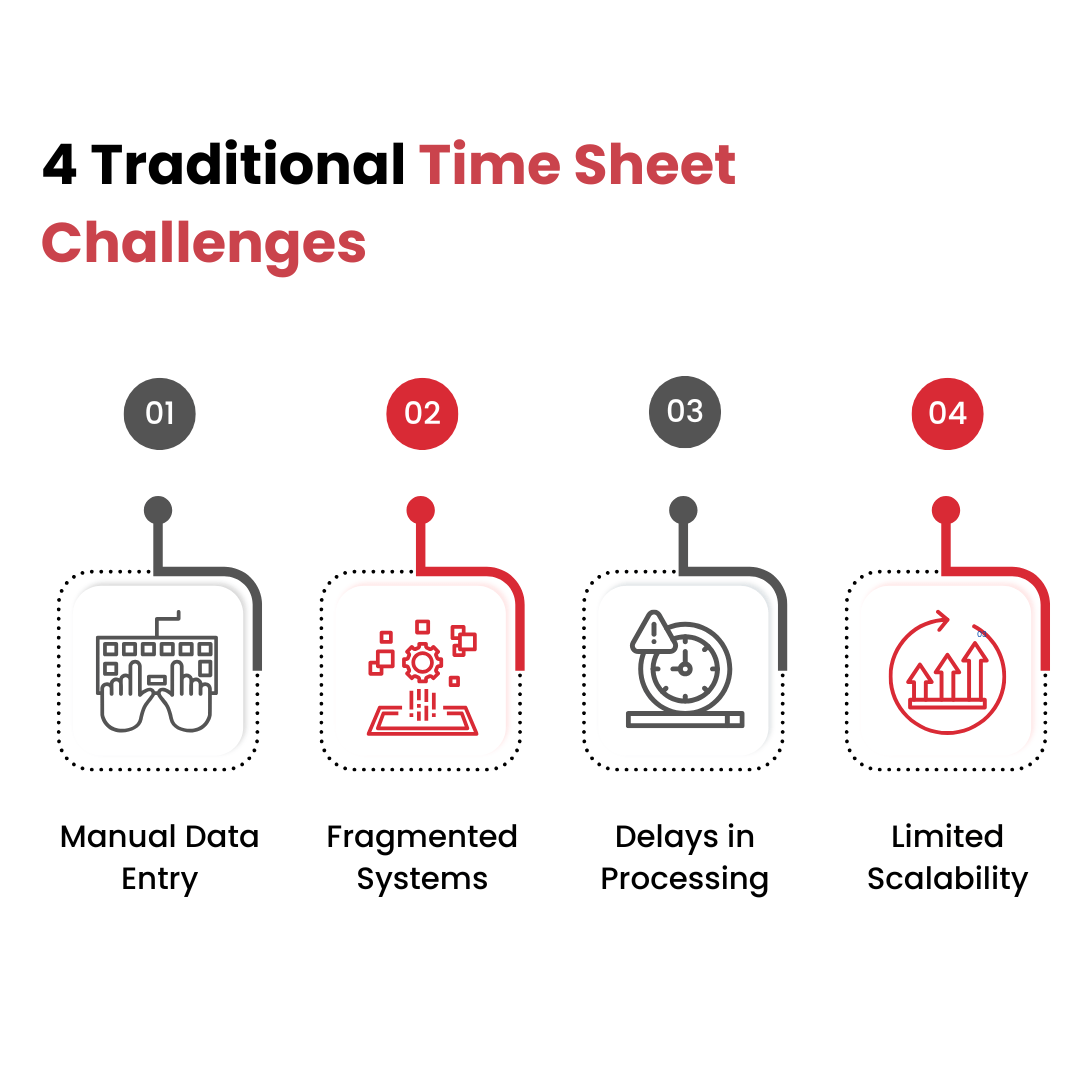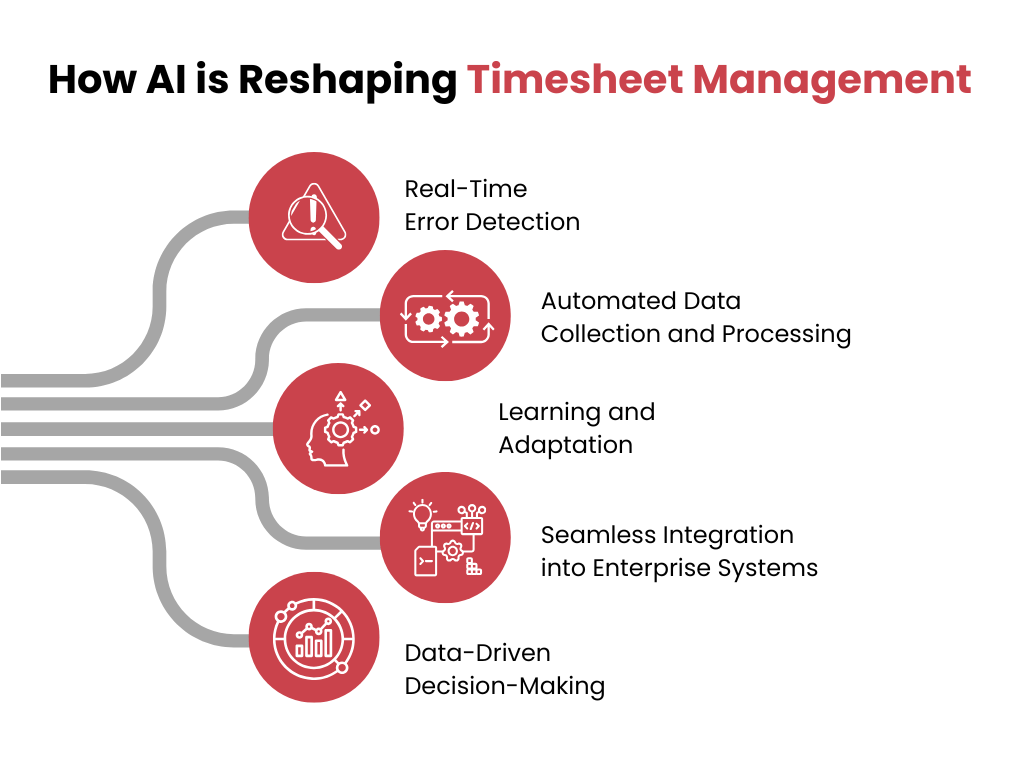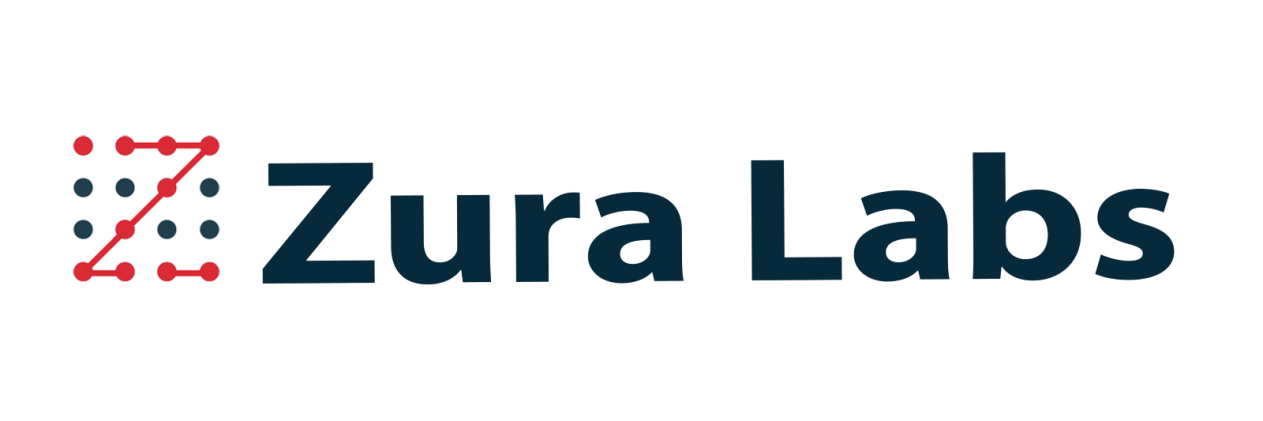Estimated reading time
Introduction
For Emily, a payroll and accounting manager at an IT company, navigating the chaos of timesheet management is not just a monthly ordeal – it’s a constant battle, surfacing weekly, bi-weekly, or whenever the invoicing calendar dictates. The issue affects not only her but her entire team as well.
Every cycle begins the same way: Emily finds herself chasing timesheets from employees across various departments. The marketing team submits their signature colorful spreadsheets, while the development team relies on a convoluted shared document. When timesheets finally trickle in, they arrive in a baffling array of formats—images, PDFs, and even hastily scanned handwritten notes. Worse still, some employees forget to send their timesheets altogether, forcing Emily’s team to waste valuable hours sending reminders and following up.
Even when the timesheets arrive, they’re often incomplete, unapproved, or filled with errors. Her team is left to reconcile these inconsistencies, delaying critical payroll and invoicing tasks. What should be a straightforward process of gathering and validating work hours has turned into an exhausting scavenger hunt, draining time and energy from more valuable work. Managing timesheets comes with their own unique challenges.
Timesheet Challenges
-
-
-
- Sophisticated fraud detection risks, including proxy punching and ghost employee entries
- Massive data integration challenges from multiple tracking platforms
- Navigating complex legal compliance requirements across various work arrangements, including remote, hybrid, and contract roles
- Never ending reminders for employees who submit incomplete or incorrect time logs
-
-
The HR team would spend the entire day cross-referencing these fragments, frustration mounting with each misaligned entry. One tiny mistake could derail the entire payroll process. A developer’s extra hour might go unnoticed. A sales representative’s overtime work could be miscalculated.
Manual timesheet entries are not only frustrating but also prone to errors. Any delays in processing these entries could potentially cost the company significant money, turning each timesheet into a ticking financial time bomb. It would be an endless domino effect.
——————————————————————————————————————————————-
The Hidden Cost of Manual Timekeeping
Although it seemed like a simple administrative task, this in fact turned out to be a complex ecosystem of potential errors. Every timesheet represents more than just hours worked. It’s a critical financial and operational document that could alter a company’s efficiency.
The traditional way of timesheet management felt like solving a rubrics cube with mismatched colors. Inconsistent data collection methods created several blind spots. The manual entry introduced human error. Approval processes became bottlenecks that slowed down everything from payroll to project billing.
For growing companies, these inefficiencies weren’t just frustrating but also expensive. The excess time spent on manual reconciliation, delayed payments, compliance risks, and potential legal complications created a silent drain on resources.

The Technological Lifeline
Manual data entry, human errors, and fragmented systems slow down payroll processing and consume valuable resources. In an era defined by digital transformation, organizations are increasingly turning to Artificial Intelligence and Automation to revolutionize this critical function. Using AI here not as a cold, robotic solution, but as a smart, adaptive system designed to understand and streamline workforce management. Imagine a solution that could read, understand, and process timesheets from multiple sources instantly. A system that could detect errors before they became problems, that could learn and adapt to unique organizational workflows. This wasn’t about replacing human workers. It was about empowering them. By automating the tedious aspects of timesheet management, companies could redirect human intelligence toward more strategic, creative tasks.
——————————————————————————————————————————————-
AI-Powered Transformation
Artificial Intelligence introduces a revolutionary approach to timesheet management. Unlike traditional methods, AI-powered platforms can extract, read, and consolidate timesheet data from diverse sources with unprecedented accuracy. The technology goes beyond simple data collection, offering a comprehensive solution that addresses the most persistent challenges in workforce management.
Real-time error detection becomes a game-changer. AI systems proactively identify incomplete entries, track unapproved time records, and ensure compliance with organizational policies. Machine learning algorithms continuously improve, resolving recurring exceptions with minimal human intervention and optimizing processes to reduce administrative overhead.
True magic lies in seamless integration. Modern AI platforms connect effortlessly with existing accounting and HR systems, creating a centralized management approach that transforms how organizations track and process time.

5 Ways How AI is Reshaping Timesheet Management
AI is completely changing the way we handle timesheets. From saving time to improving accuracy, here’s how it’s making a difference:
Automated Data Collection & Processing
Imagine we don’t have to do manual entry anymore for timesheet data. AI can extract information from various places—spreadsheets, emails, and even specialized software—and keep it all together for you.
Real-Time Error Detection
Using AI, you don’t need to wait for errors to pile up. AI identifies discrepancies in time entries, missing approvals, or calculation errors, flagging them before they become a problem.
-
-
-
- Flags incomplete or wrong timesheets quickly.
- Tracks unapproved entries to keep payroll on track.
- Makes sure everything follows company policies and labor laws.
-
-
Continuous Learning & Adaptation
The more you use it, the smarter AI gets. Machine learning helps it understand your company’s workflow, so it can resolve recurring issues with little to no input from you. You can reduce a lot of time spent on admin tasks.
Easy Integration with Your Existing Systems
You don’t need to stress over completely changing your software infrastructure. Modern AI tools integrate seamlessly with the systems you already use like your current HR and accounting systems, eliminating the need to replace your existing software. Every time sheet information is gathered in one place, simplifying its handling and monitoring. Moreover, you don’t need to invest in extra software—AI offers a more intelligent and effective alternative without increasing expenses.
Data-Driven Decision-Making
AI doesn’t just automate tasks, but it also unlocks powerful insights. By analyzing workforce data in real-time, it empowers you to make smarter decisions. You’ll gain detailed analytics on your team, helping you understand trends and performance better. AI also assists in resource allocation, ensuring you use your workforce more effectively. Plus, with accurate forecasting, it supports future planning, making sure you’re always ahead of the game.
AI isn’t just about speeding things up. It is about helping you make better decisions and manage timesheets more efficiently.
——————————————————————————————————————————————-
Real World Impact
The potential isn’t merely hypothetical. Technology start-ups have cut down on payroll processing from several days to just a few hours. Retail chains have refined their shift scheduling to lessen the need for overtime. Healthcare organizations are now able to adhere to labor laws with ease, a feat never achieved. Manufacturing companies have gathered timesheet information in one central location, significantly reducing the time it takes to process it. Creative agencies can now pinpoint issues with project inefficiency with incredible accuracy.
Recent studies show that automation in timesheet management can bring impressive results:
-
-
-
- Up to 80% time savings on manual timesheet entry and correction
- A reduction of up to 90% in payroll errors, ensuring better accuracy and compliance
- Around 10-20% reduction in administrative costs, freeing up HR teams for higher-value tasks
- Overall improvements in productivity by automating time tracking and reporting
-
-
It’s no wonder that most organizations are highly satisfied with the returns they gain from automating their business tools and processes. For countless organizations, the timesheet revolution is only just beginning.
Are you ready to change how your organization manages timesheet? Book a demo here.



One comment
Emmett4132
April 14, 2025 at 1:16 pm
https://vitz.ru/forums/index.php?autocom=gallery&req=si&img=4805